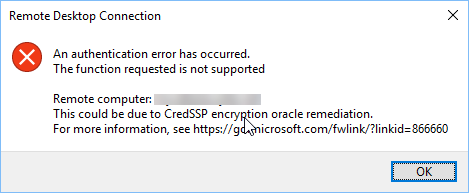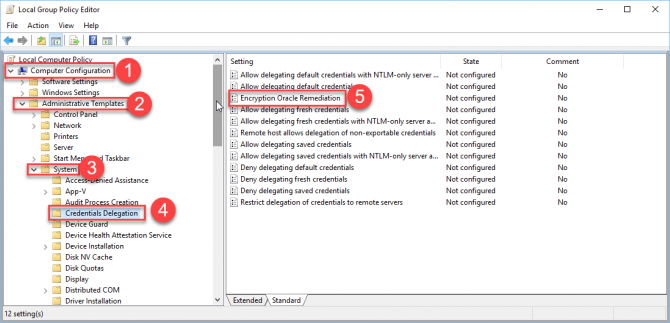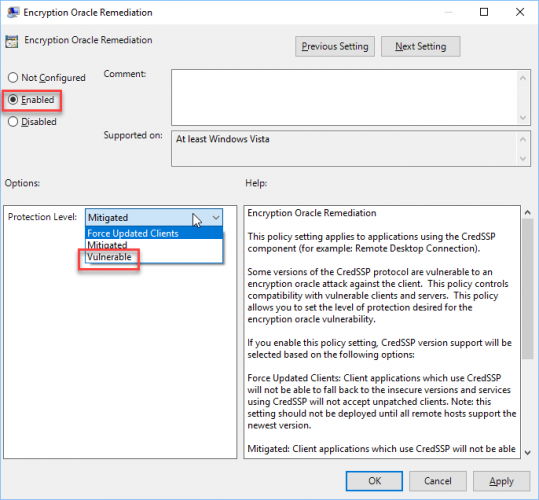After the May 2018 update to Windows 10, most computers running Remote Desktop Windows functionality are facing RDP authentication error, function requested is not supported issue where they get the following error while logging in to a remote computer via RDP.
An authentication error has occurred.
The function requested is not supportedRemove computer: [computername]
This could be due to CredSSP encryption oracle remediation.
For more information, see https://go.microsoft.com/fwlink/?linkid=866660

This is due to a recent vulnerability fixed in Windows 10 and Windows 7. After installing the latest update KB4103727 for Windows 10 Version 1709 and KB4103718 for Windows 7, you will start getting this error.
If you are running Remote Desktop Protocol on your network and allow connections to your server, this error should probably fix this error immediately.
Table of Contents
What is RDP authentication error?
Windows uses CredSSP protocol (Credential Security Support Provider) for authenticating clients on the RDP servers.
A serious vulnerability was found in CredSSP protocol which could impact the security of both the server and the client.
To fix this issue, Microsoft introduced the Network Level Authentication (NLA) protocol which works along with CredSSP and pre-authenticates RDP client users over TLS/SSL or Kerberos.
In a situation where the server does not have the required Windows update patch, an updated client computer will refuse to connect to the non-secure server because Microsoft makes it mandatory to enable NLA for secure remote desktop connection.
4 solutions to RDP Authentication Error Function Requested Is Not Supported
Let’s go through some resolutions to this problem.
Solution 1: Install updates on the target computer
The first and most recommended solution to this issue is to update the target computer on which you are trying to connect remotely. Go to Windows Update and check for updates. Install all the updates specifically related to CVE-2018-0886.
Specifically, if the target computer is running Windows Server 2016, you should install KB4103723 and if you are using Windows Server 2012 R2, then you should install KB4103725.
A server reboot will be required after installing these updates.
If you do not want to update your computer or if it’s not in your access, then you can try the other solutions listed below.
Solution 2: Using Group Policy
- Go to Run –> gpedit.msc to open Group Policy Editor.
- Go to the following policy path:
Computer Configuration -> Administrative Templates -> System -> Credentials Delegation


gpupdate /force
This will apply the group policy immediately and you will be able to use the Remote Desktop without restarting the computer.
Solution 3: Using Registry Editor
The same can be achieved through Windows Registry. This method is especially useful for Windows Home editions where there is no Group Policy Editor (although you can install gpedit.msc easily). Here are the steps:
- Go to Run –> regedit to open Registry Editor.
- Go to the following key:
HKLM\Software\Microsoft\Windows\CurrentVersion\Policies\System\CredSSP\Parameters - In the right-hand pane, edit the DWORD value of AllowEncryptionOracle key to 2.
- If you can’t find the key, you will need to create it. Alternatively, you can download the following registry file, double-click to run it and it will automatically create a key and set it up for you.
 CredSSP Parameters Registry (364 bytes, 13,374 hits)
CredSSP Parameters Registry (364 bytes, 13,374 hits)
This is a simple registry file. If you don’t want to download it, just create a text file with the following contents:
Windows Registry Editor Version 5.00 [HKEY_LOCAL_MACHINE\SOFTWARE\Microsoft\Windows\CurrentVersion\Policies\System\CredSSP\Parameters] "AllowEncryptionOracle"=dword:00000002
Save the file in with .reg extension and run the file to add these values to the Windows Registry.
Solution 4: Uninstall updates from your computer
Another workaround is to uninstall the updates from your computer. If you are using Windows 10 Version 1709, you should uninstall the update KB4103727 and KB4103718 if you’re running Windows 7. Uninstalling these updates requires the computer to be restarted.
Final words
Although you can use any of the above mentioned methods to resolve this issue of RDP Authentication Error Function Requested Is Not Supported, I recommend that you either use Solution 1 (install latest Windows updates) or Solution 2 (using local group policy) for the resolution.
I had the same issue with my network. All the above mentioned solutions worked for me on my company network. I fixed it by updating all my Windows Server installations and also the client computers. There were some environments which required not updating the server at all. I used the second method to fix RDP authentication error messages from those servers.
What are your thoughts about this?

31 comments
sachin
i was getting the same issue. but by resetting password i was able to connect
BOSS
option 1 worked
Hasbullah Marwan
Windows 10 home not work with solution 2. But work fine solution 3
abdelhak
Solution 2: Using Group Policy its worked in windows-10
Thank you very much
Kers
Thank you! Solution number 2 did the trick!
Raza
Thanks for the solutions provided. Solution 2 worked out for me.
Devgela
Solved my problem by Solution 2
Suraj Sawant
Solved my problem using solution for windows7 pc
@nup
Hey Thanks its helped me. 3rd option
Furqan
Thanks mate. Solution 2 worked for me. Thanks a lot.
Faizan Ahmad
Solved by using method number 2 (Group Policy) Thanks a lot to write the exact solution.
Nilgiri Arya
Hey Thanks its helped me. 2nd option. Thank you for the help again.
Sathish
Solution 2 worked for windows 10 home x64. thanks a lot
Acharya
Thanks a lot.
Using Solution 2: Using Group Policy … I connected to server…
Jayaram.n
Solution 2 worked for windows 10 home x64. thanks a lot
Navin Kumar
Solution 2 worked for windows 10 home x64. thankyou
daniel sitompul
solved.!!! simple but awesome
Bhan
it works very well by editing in group policy
705H
Solution 3 worked for windows 10 home x64. thankyou
Geoff
Option 2 worked great. As I don’t have access to the server and this comes up every time a new server is built, Option 1 was out of the question. Only concern is if there are any security risks in leaving this GP setting in place – a bit concerning, when you set something to “Vulnerable”.
Usman Khurshid
Yes definitely this will keep your systems vulnerable. The better practice is to update all your Windows systems to the latest versions.
M
Well, in option 3, I don’t find From the right-hand pane, open Encryption Oracle Remediation.
& in option 4, Also doesn’t exist the entry as HKLM\Software\Microsoft\Windows\CurrentVersion\Policies\System\CredSSP\Parameters
it exist until HKLM\Software\Microsoft\Windows\CurrentVersion\Policies\System
but missing “CredSSP\Parameters”
I am using Win2012r2
sam
Thanks a lot solution 2 Works very well for me
Ricko
Number 1 worked for me
Thanks for taking the time to write it all up
Fausto
Thanks a lot solution 2 Works very well for me
Raymundo
La mas facil
Solution 3: Using Registry Editor
Gracias
Martin
I solved it on a Win7 x64 WS installing the update from 05/05/2018, not the monthly rollup. Thank you for sharing this solution with the community.
Noor Mohammad
Solution 2: Using Group Policy its worked in windows-10
Thank u very much……..
Alex
Solved by using method number 3 (registry editor)
STEFANO
Also solved on PC with windows 7 with 3 method.
Test
Number 4 worked for a windows 7 pc trying to connect to windows server 2016 .
Thanks